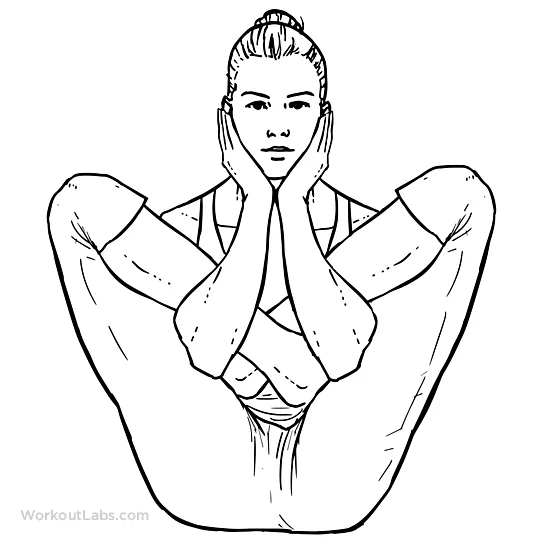Garbha Pindasana
What is Garbha Pindasana?
Garbha Pindasana is a very complex pose, which depicts the fetus inside the mother’s womb. It is basically a combination of the Lotus pose and the Complex Lotus pose. A fetus is very flexible in nature, and grows inside the womb, in a manner which is beneficial for both itself and the mother. This is a deep yoga posture that depicts life before birth. However, it is also a symbol of the life energy which leaves a body after demise.  The name can be traced to the Sanskrit verses, and the same has been found to be of the following etymology.
The name can be traced to the Sanskrit verses, and the same has been found to be of the following etymology.
- Garbha means ‘Womb’
- Pinda means ‘Embryo’
- Asana means ‘Pose’
So, you can call it the embryo in the womb pose. It is basically a seated balancing pose. You will be practicing it in the advanced stages of the Ashtanga Primary series. You have to stretch the body a lot, apart from bending it forward. You have to balance your body on the coccyx. Moreover, you have to insert the hands from between the thighs and calf muscles, and hold your ears, in a balanced Padmasana. It happens to be the 17th pose in the series, that is seated.
How To Do Garbha Pindasana?
You can do the garbha pindasana after some practice. It is an advanced level asana or pose, that is best performed under the tutelage of a learned yoga expert.
- To do this pose, or the garbha pindasana, you have to sit in the Padmasana at first.
- Then, insert the arms on either side and insert them in between the thighs and calf muscles, of either leg and fold the arms at the elbows.
- While doing this, you have to lift the cross-legged portion of the body, upwards.
- When you fold your hands, to hold the ears, they will assist you to raise the lower part of the body.
- In this asana, you have to balance the body on the coccyx.
- You can hold the asana for 5-6 breaths, or as long as it is possible for you.
- You have to look straight ahead.
- When you are ready to release the pose, leave the ears, and lower your legs and slowly loosen the arms.
- You can cross the legs in the other way and repeat the pose.
Modifications and Variations
- If you are unable to hold the pose, and tend to fall down, you can use a yoga strap. You can also use the strap to clasp the hands together.
Read More: Why Is Kundalini Yoga Dangerous? The Truth About Its Risks and Rewards
Moreover, if you are unable to sit in the Padmasana, while trying this pose, you can sit with cross ankles. You can wrap the hands around your knees and clasp the hands. In the beginning, it might be difficult for you to hold the ears with your hands, so you can hold the hands in the Anjali Mudra. You can also do garbha pindasana in Ardha Padmasana. You can also try Uttana Kurmasana and Baddha Padmasana as variations for the Garbha Pindasana. You have to breathe slowly but deeply, and hold the pose for 5-6 breaths in the final pose. Your gaze should be in front.
Safety Precautions Decoded
- You have to maintain the safety guidelines, to do this pose properly.
- Always ensure to do the asana or pose, on an empty stomach. So, you will get the energy to do the pose, without any distractions. Your body will be able to utilize all the energy to do the pose as well.
- Your bowel and bladder should be empty, while doing this asana. So, that there is no hindrance in doing the asana.
- You have to keep your spine erect while doing the pose. Do ensure that the spine is not rounded. To balance the body properly, you have to insert one hand at a time, from between the calf muscles and the thighs.
- If you are unable to reach the ears you can also form a cup with your hands, and rest the chin on it.
- You have to maintain the balance of the entire body on your buttocks, So, that you do not fall off.
Do this asana with the help of your peers and teachers initially for maximum assistance.
Who Can Do This Asana and Who Cannot?
Garbha pindasana is a complex one, that comes 22nd in the Ashtanga Primary series. So, you should perform it under supervision.
- Expecting mothers should avoid doing it.
- If you have lower back pain, then you should avoid this asana.
- If you are suffering from Sciatica, you should avoid this asana.
- In case of knee injuries, or any surgery, you must avoid this asana.
- If you have pain or any other problem, then also you should avoid doing this asana.
- Anyone who is not well-conversant with body-breath awareness must not do this asana, as the benefits will not be applicable.
- If you have piles or inflamed prostrate glands, you must not do this asana.
- If you have balancing issues due to Vertigo or Migraine, you must avoid this asana.
Benefits of Garbha Pindasana
If you practice this asana on a daily basis, you will get its myriad benefits. The benefits are mentioned underneath in complete details.
- It burns a lot of fat from the body, as it works up the abdominal muscles. This causes the muscles to contract.
- It also increases the strength of the muscles of the entire body, as you have to hold the pose on the coccyx.
- The asana or pose also stimulates the Manipura Chakra. Thus, you are able to maintain your emotional health and ward off all kinds of negative emotions.
- Your digestion is also likely to improve as this asana creates some pressure on the abdomen. The organs get a gentle massage as well.
- Garbha pindasana also activates the parasympathetic nervous system. Thus, you are bound to get relief from anxiety, stress, and tension.
- Garbha pindasana is useful to improve the functioning of the internal organs like the spleen, pancreas, liver, and kidneys. This helps to maintain the flow of hormones and also helps in proper detoxification.
Deepen Your Yoga Practice with Hari Om Yoga Vidya School
Located in the heart of Rishikesh, Hari Om Yoga Vidya School is a place where ancient yogic wisdom meets modern teaching techniques. As a top yoga school in Rishikesh, we are committed to providing authentic, immersive yoga education in a peaceful, spiritual setting. Recognized as one of the best yoga schools in Rishikesh, we offer structured training programs designed to help you evolve in your practice, whether you are a beginner or an experienced yogi.
If you’re searching for a yoga school in Rishikesh that focuses on holistic learning, experienced teachers, and a supportive community, look no further!
Read More: Everything You Need to Know About Kundalini Yoga Teacher Training
Explore Our Yoga Teacher Training & Retreats
At Hari Om Yoga Vidya School, we offer a range of courses tailored for different levels of practitioners:
✅ 100-Hour Yoga Teacher Training in Rishikesh – A foundational course for those looking to begin their yoga journey.
✅ 200-Hour Yoga Teacher Training in Rishikesh – An internationally recognized certification for aspiring yoga teachers.
✅ 300-Hour Yoga Teacher Training in Rishikesh – Advanced training to deepen your practice and refine your teaching skills.
✅ 7-Day Yoga Retreat in Rishikesh – A rejuvenating escape into yoga, meditation, and self-discovery.
✅ 10-Day Yoga Retreats in Rishikesh – A transformative experience that blends yoga, relaxation, and Himalayan serenity.
Join us for a life-changing experience and become part of our global yoga family! 🌿✨



